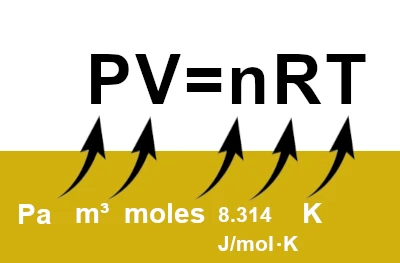
Image Description: The relationship between pressure, volume, and temperature is described by the ideal gas law. For example, if the temperature decreases at constant volume, the pressure also decreases.
The ideal gas law, or equation, is one of the most fundamental concepts in thermodynamics. It connects four important variables to describe a gas: pressure (\(P\)), volume (\(V\)), temperature (\(T\)), and the quantity of gas (\(n\)).
The ideal gas law allows us to model the behavior of ideal gases, which are gases whose particles do not interact with each other except for collisions. This model is a valid approximation at moderate temperatures and pressures, where real gases behave almost like ideal gases.
The equation tells us that, for a given amount of gas (\(n\)) and constant temperature (\(T\)), pressure and volume are inversely related. This means that if you increase the volume, the pressure decreases, and vice versa, as long as temperature and quantity of gas remain constant.
When using a bicycle pump, the pressure of the gas inside the pump increases as you compress the air. The thermal effect observed, namely that the pump heats up, is a direct consequence of the ideal gas law.
When you operate the pump, you exert a force to reduce the volume of the gas inside the pump. According to the ideal gas law, if the volume (V) decreases while maintaining a constant amount of gas (n) and a constant number of moles, the pressure (P) must increase. When compressing a gas, it releases energy in the form of heat.
The phenomenon where the refrigerator door becomes difficult to open after being left open for a while, especially in summer, can be explained by the ideal gas law.
When you leave the refrigerator door open for a while, the air inside the refrigerator mixes with the warm ambient air. This mixture of warm air raises the temperature inside the refrigerator. When you close the door, the gas inside the refrigerator starts to cool down again, and its pressure decreases. However, the outside air exerts a greater pressure on the closed door, making it harder to open.
When you turn a hot jam jar upside down after sealing it, the air inside the jar undergoes rapid cooling. As it cools, the air inside the jar contracts.
According to the ideal gas law, if the temperature decreases at constant volume, the pressure inside the jar also decreases. This occurs because the gas loses kinetic energy and the air molecules occupy less space. This reduction in temperature and pressure creates a partial vacuum inside the jar compared to the external atmospheric pressure. Because of this partial vacuum, you may hear a slight "pop" when the jar is turned upside down, and the lid slightly deforms inward. This happens because the external pressure is greater than the pressure inside the jar. This phenomenon is not a perfect vacuum, but a slight underpressure that helps create a kind of airtight seal around the lid.
The ideal gas law shows that pressure is directly related to temperature and volume in a gas. In the case of boiling water, steam escapes from the surface of the water. When the vapor pressure equals the atmospheric pressure, the boiling point is reached, and evaporation maintains that boiling temperature.
At high altitudes, atmospheric pressure decreases compared to sea level. This affects the boiling point of water, which is closely linked to the surrounding pressure. At high altitudes, atmospheric pressure is lower, so water boils at a lower temperature. For example, at 2000 meters, water boils at around 93°C, and at 4000 meters, at 86°C.
Cooking pasta depends on the temperature at which the water remains during boiling. Since water boils at a lower temperature at high altitude, the temperature at which pasta is cooked is also lower. Since the water cannot reach the higher temperatures found at sea level (100°C), pasta cooking at high altitudes will be slower.
The operation of a pressure cooker can be explained using the ideal gas law, particularly the relationship between pressure, temperature, and volume.
A pressure cooker works by increasing the pressure inside the pot, which raises the temperature at which the water inside can boil. As the water heats up, its temperature increases, and the steam generates progressively higher pressure inside the pressure cooker.
At constant temperature, if we increase the pressure (with the volume remaining constant since the lid is closed), the boiling point of the water also increases. In other words, in the pressure cooker, water can reach a temperature higher than 100°C before it starts to boil. For example, at a pressure of about 2 bars (twice the atmospheric pressure), water boils at around 120°C.
The ideal gas law shows us that the temperature at which a gas (or here, water vapor) will boil depends directly on the pressure. At higher pressure, the temperature at which water molecules have enough energy to transition from liquid to gaseous state (vapor) increases.
The equation \( PV = nRT \) provides a simple but powerful view of the behavior of gases. While it may not be applicable in all cases (such as for gases at high pressure or low temperature), it forms the foundation of many studies in thermodynamics and remains a fundamental tool for physicists and engineers.